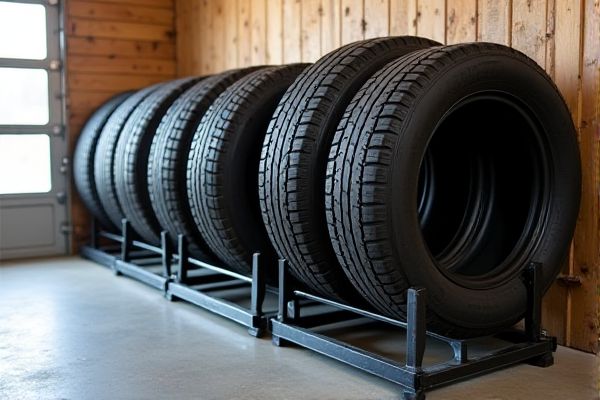
Choosing between a tire rack and a floor tire stand depends on your available space and storage needs, with a tire rack offering vertical storage efficiency while a floor tire stand provides easy accessibility and mobility. Explore the pros and cons of each option to determine which best suits your tire organization and maintenance routine.
Table of Comparison
| Feature | Tire Rack | Floor Tire Stand |
|---|---|---|
| Storage Capacity | Holds multiple tires vertically | Typically holds 1-2 tires horizontally |
| Space Efficiency | Optimizes vertical space, less floor area | Requires more floor space per tire |
| Stability | Generally stable with secured mounting | Stable but prone to tipping with uneven loads |
| Portability | Usually fixed, less portable | Portable and easy to move |
| Price | Higher initial cost | Lower cost |
| Best Use | Garage or workshop with limited floor space | Quick access and temporary storage |
Introduction to Tire Rack vs Floor Tire Stand
Tire racks offer vertical storage that maximizes space efficiency and keeps tires organized off the ground, reducing flat spots and moisture buildup. Floor tire stands provide easy access and mobility, accommodating frequent tire changes and allowing for quick relocation within a garage or workshop. Both solutions support tire longevity by enabling proper ventilation and reducing deformation risks during storage.
Key Differences Between Tire Racks and Floor Tire Stands
Tire racks are designed to store multiple tires vertically on shelves, maximizing storage space and improving organization, whereas floor tire stands hold tires individually on the ground, offering easy accessibility and mobility. Tire racks are ideal for garages or shops with limited floor space, while floor tire stands provide flexibility for quick tire changes and seasonal swaps. Your choice depends on whether you prioritize efficient storage capacity or convenient tire handling.
Space Efficiency: Tire Racks Compared to Floor Tire Stands
Tire racks maximize vertical storage capacity, allowing multiple tires to be organized in a compact footprint, making them ideal for limited spaces. Floor tire stands consume more horizontal area since each tire rests directly on the floor, reducing overall space efficiency. Compared to floor stands, tire racks enable better floor clearance and easier access, improving garage or workshop organization.
Durability and Material Considerations
Tire racks typically feature heavy-duty steel construction with powder-coated finishes, providing superior durability and resistance to rust and corrosion compared to floor tire stands, which are often made from lighter materials like plastic or thin metal. The robust build of tire racks ensures long-term stability and weight support for multiple tires, while floor tire stands may be more prone to cracking or bending under heavy loads. Choosing the right storage solution for your tires depends on balancing durability needs with space and mobility preferences.
Tire Protection and Storage Safety
Tire racks provide elevated storage that keeps tires off the ground, reducing exposure to moisture and potential deformation, while floor tire stands offer convenient access but may increase the risk of tire contact with harmful surfaces. You benefit from tire racks' enhanced protection against environmental damage and improved air circulation, which prolongs tire life and maintains shape integrity. Choosing the right storage solution ensures safety by preventing tire deformation and minimizing hazards associated with unstable stacking or ground contact.
Setup and Installation Process
Tire racks typically require wall mounting or bolting to the floor, involving anchors, screws, and sometimes tools like drills for secure installation, making them more permanent and stable. Floor tire stands offer a simpler setup with no need for mounting, allowing users to place and move tires freely without tools or hardware. The floor tire stand's portability suits frequent rearrangements, while tire racks demand precise measuring and hardware for proper alignment and safety.
Cost Comparison: Tire Racks vs Floor Tire Stands
Tire racks generally offer a more cost-effective storage solution compared to floor tire stands, especially for those needing to store multiple sets of tires. Floor tire stands tend to be pricier due to their sturdy construction and ease of mobility, making them ideal for garages or workshops with limited space. Budget-conscious buyers often prefer tire racks for long-term storage, while floor tire stands are favored for convenience despite the higher initial cost.
Maintenance and Cleaning Requirements
Tire racks require minimal maintenance, typically involving occasional dusting and ensuring bolts are tight to keep your tires secure. Floor tire stands demand more frequent cleaning to prevent dirt and moisture accumulation, which can lead to rust or damage, especially if placed in damp environments. Choosing the right option depends on your willingness to perform regular upkeep to maintain tire longevity and safety.
Best Applications: Home, Garage, and Commercial Use
Tire racks are ideal for commercial use and large garages where maximizing vertical storage space is crucial, as they can hold multiple tires securely and organized. Floor tire stands are best suited for home use or smaller garages, offering easy access and flexibility for storing a few tires without requiring wall installation. Your choice depends on the scale of storage needed and the available space in your home, garage, or commercial setting.
Conclusion: Choosing the Right Tire Storage Solution
Selecting between a tire rack and a floor tire stand depends on your available space and tire volume. Tire racks offer vertical storage, maximizing garage space and keeping tires organized, while floor stands provide easy access and mobility for fewer tires. Your choice should optimize convenience and space efficiency to protect tire condition and extend lifespan.
 homyna.com
homyna.com